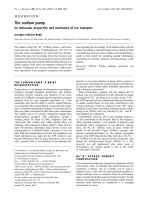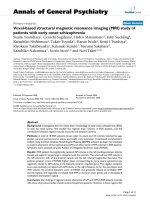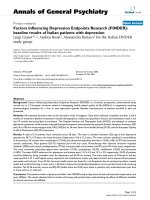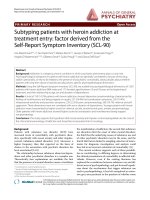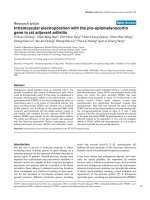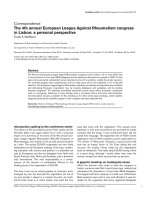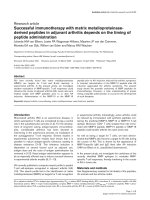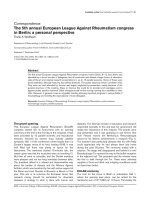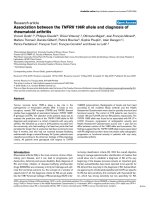Báo cáo y học: "Mimotopes selected with neutralizing antibodies against Multiple Subtypes of Influenza A" pot
Bạn đang xem bản rút gọn của tài liệu. Xem và tải ngay bản đầy đủ của tài liệu tại đây (536.16 KB, 25 trang )
Virology Journal
This Provisional PDF corresponds to the article as it appeared upon acceptance. Fully formatted
PDF and full text (HTML) versions will be made available soon.
Mimotopes selected with neutralizing antibodies against Multiple Subtypes of
Influenza A
Virology Journal 2011, 8:542
doi:10.1186/1743-422X-8-542
Yanwei Zhong ()
Jiong Cai ()
Chuanfu Zhang ()
Xiaoyan Xing ()
Enqiang Qin ()
Jing He ()
Panyong Mao ()
Jun Cheng ()
Kun Liu ()
Dongping Xu ()
Hongbin Song ()
ISSN
Article type
1743-422X
Research
Submission date
31 August 2011
Acceptance date
15 December 2011
Publication date
15 December 2011
Article URL
/>
This peer-reviewed article was published immediately upon acceptance. It can be downloaded,
printed and distributed freely for any purposes (see copyright notice below).
Articles in Virology Journal are listed in PubMed and archived at PubMed Central.
For information about publishing your research in Virology Journal or any BioMed Central journal, go
to
/>For information about other BioMed Central publications go to
© 2011 Zhong et al. ; licensee BioMed Central Ltd.
This is an open access article distributed under the terms of the Creative Commons Attribution License ( />which permits unrestricted use, distribution, and reproduction in any medium, provided the original work is properly cited.
Virology Journal
/>
© 2011 Zhong et al. ; licensee BioMed Central Ltd.
This is an open access article distributed under the terms of the Creative Commons Attribution License ( />which permits unrestricted use, distribution, and reproduction in any medium, provided the original work is properly cited.
Mimotopes selected with neutralizing antibodies
against Multiple Subtypes of Influenza A
ArticleCategory
: Research
ArticleHistory
: Received: 31-Aug-2011; Accepted: 21-Nov-2011
© 2011 Zhong et al; licensee BioMed Central Ltd. This is an Open Access
article distributed under the terms of the Creative Commons Attribution
ArticleCopyright : License ( which permits
unrestricted use, distribution, and reproduction in any medium, provided
the original work is properly cited.
Yanwei Zhong,Aff1†
Corresponding Affiliation: Aff1
Phone: +86-10-63879107
Fax: +86-10-63879107
Email:
Jiong Cai,Aff2†
Email:
Chuanfu Zhang,Aff3†
Email:
Xiaoyan Xing,Aff1M
Email:
Enqiang Qin,Aff1
Email:
Jing He,Aff1
Email:
Panyong Mao,Aff1
Email:
Jun Cheng,Aff4
Email:
Kun Liu,Aff3
Email:
Dongping Xu,Aff1
Email:
Hongbin Song,Aff3
Corresponding Affiliation: Aff3
Phone: +86-10-63879107
Fax: +86-10-63879107
Email:
Aff1
Pediatric Liver Disease Research Laboratory, Institute of Infectious
Diseases, Beijing 302 Hospital, Beijing, China
Aff2
PUMC Hospital, PUMC & CAMS, Beijing 302 Hospital, Beijing, China
Aff3
Institute of Disease Control and Prevention, Academy of Military
Medical Sciences, Beijing 302 Hospital, Beijing, China
Aff4
Liver Center, Beijing Ditan Hospital, Capital Medical University,
Beijing 302 Hospital, Beijing, China
†
These authors contributed equally to this work.
Abstract
Background
The mimotopes of viruses are considered as the good targets for vaccine design. We prepared
mimotopes against multiple subtypes of influenza A and evaluate their immune responses in flu
virus challenged Balb/c mice.
Methods
The mimotopes of influenza A including pandemic H1N1, H3N2, H2N2 and H1N1 swine-origin
influenza virus were screened by peptide phage display libraries, respectively. These mimotopes
were engineered in one protein as multi- epitopes in Escherichia coli (E. coli) and purified.
Balb/c mice were immunized using the multi-mimotopes protein and specific antibody responses
were analyzed using hemagglutination inhibition (HI) assay and enzyme-linked immunosorbent
assay (ELISA). The lung inflammation level was evaluated by hematoxylin and eosin (HE).
Results
Linear heptopeptide and dodecapeptide mimotopes were obtained for these influenza virus. The
recombinant multi-mimotopes protein was a 73 kDa fusion protein. Comparing immunized
infected groups with unimmunized infected subsets, significant differences were observed in the
body weight loss and survival rate. The antiserum contained higher HI Ab titer against H1N1
virus and the lung inflammation level were significantly decreased in immunized infected
groups.
Conclusions
Phage-displayed mimotopes against multiple subtypes of influenza A were accessible to the
mouse immune system and triggered a humoral response to above virus.
Keywords
Influenza, Mimotopes, Phage display, Vaccination, Virus challenge
Background
Influenza A can cause significant morbidity and mortality levels in human. The human influenza
A pandemics killed about millions of people worldwide over the past (1918 H1N1 Spanish, 1957
H2H2 Asian, 1968 H3N2 Hong Kong, and 2009 H1N1 Mexico) and seasonal influenza A killed
more than 250,000 each year [1-3]. The pathogenic viruses are classified by their surface
proteins: hemagglutinin and neuraminidase [4,5]. There are 16 hemagglutinin subtypes (H1-16)
and 9 neuraminidase subtypes (N1-9) on the influenza viral surface [6]. Although Neuraminidase
inhibitors and amantadine have been used to treat influenza patients, they have limited efficacy
and their widespread use is likely to result in resistant viruses [7,8]. Consequently, vaccination
remains the most effective strategy to prevent influenza virus attack [9,10]. Developing a new
vaccine which induces a broad immune response against multiple subtypes of influenza A is a
urgent strategy for the disease control.
The viruses mimotopes are considered to be good targets for the vaccine design since they can
induce antibodies against both viral original and mutant antigen [11]. Protective immune
responses by mimotope immunization have been verified in many infectious diseases [11-14].
The phage display libraries have been used for novel therapeutic and diagnostic drugs
development in our and others previous studies [15-18]. Random peptide phage libraries provide
rich resources for selecting sequences that mimic conformational epitopes (mimotopes) either
structurally or immunologically [11]. The aim of this study was to prepare mimotopes against
multiple subtypes of influenza A and evaluate its immune responses in Balb/c mice with flu virus
challenge.
Methods
Antibodies
C179 monoclonal antibody (A/H2N2 subtype) was purchased from Takara Bio Inc (Otsu, Shiga,
Japan); Mouse monoclonal antibody (IV.C102) against influenza virus A strain H1N1 was from
Santa Cruz (Santa Cruz, CA, USA); Purified H3N2 goat polyclonal IgG specific to influenza
A/Texas 1/77 was from Virostat (Portland, ME, USA); SIV sera were prepared from patients
hospitalized by swine-origin influenza virus A/2009 and their binding activities were tested by
ELISA. Endotoxin was removed by purification with polymyxin B chromatography. Endotoxin
levels were<0.1 unit/µg of protein by the Limulus Amebocyte Lysate QCL-1000 pyrogen test
(Cambrex).
Phage display libraries
Ph.D.-7, Ph.D.-12 and Ph.D.-C7C were produced by New England Biolabs, Inc (Ipswich, MA,
USA), with random linear 7-mer, 12-mer or cyclic 7-mer peptides fused to minor coat proteins
(pIII) of M13 filamentous phages.
Screening of phage libraries for H2N2 antibody-reactive phages
C179 (0.2 ml, 10 µg/ml) was coated on three wells of 24-wells microplate at 4°C overnight. The
coated wells were blocked with 2% bovine serum albumin (BSA) at 37°C for 1 h, then washed
with Tris•HCl buffer solution (TBS) containing 0.1% Tween-20 (TBST) for 6 times. Ten
microliter Ph.D.-7 (2×1011 pfu), Ph.D.-12 (1.5×1011 pfu) and Ph.D.-C7C (2×1011 pfu) libraries
diluted with 0.2 ml TBST were dropped into the coated wells respectively. The incubation wells
were rocked gently for 30 min, followed by discarding nonbinding phages. The binding phages
were eluted with 0.2 M Glycine-HCl (pH 2.2), 1 mg/ml BSA and neutralized with 1 M Tris•HCl
(pH 9.1). The eluted phages were used to infect log-phase bacteria ER2738, concentrated by
PEG precipitation and submitted to the second round of selection. The following selections were
performed as above except that the Tween-20 concentration was raised from 0.1% to 0.5% in the
wash steps. After 3 rounds of selection, the eluted phages were used for plaque isolation. 32
plaque clones were amplified for ELISA test and single-strand DNA preparation.
Screening of phage libraries for H1N1 antibody-reactive phages
IV.C102 (0.2 ml, 10 µg /ml) was coated on three wells of 24-wells microplate at 4°C overnight.
The blocking and bio-spanning procedures were carried as did in C179 antibody, except that the
binding phages were eluted with IV.C102 (0.2 ml, 10 µg/ml). After 3 rounds of selection, the
eluted phages were used for plaque isolation.
Screening of phage libraries for H3N2 antibody-reactive phages
H3N2 polyclonal antibody (30 µg/ml) and goat IgG (100 µg/ml) were coated respectively. After
blocking with BSA and washing with TBST for 6 times, Ph.D.-7, Ph.D.-12 and Ph.D.-C7C
libraries were added into the goat IgG-coated wells for 30 min incubation. Then, the nonbinding
phages were transferred to H3N2 polyclonal antibody-coated wells for additional 30 min
incubation. After that, the non-binding phages were discarded, and the binding phages were
eluted with H3N2 polyclonal antibody. The eluted phages were amplified in bacteria ER2738
and used in the following selections as above.
Screening of phage libraries for swine-origin influenza antibody-reactive phages
Goat anti-human IgG (100 µg/ml) was coated on six wells. After blocking, three wells were
added with diluted SIV sera (1:20), the others were added with human IgG (100 µg/ml). Then
they were placed at 4°C overnight and washed with TBST for 6 times. Peptide phage display
libraries were added into the IgG wells for 30 min incubation. Subsequently, the nonbinding
phages solutions were transferred to the sera wells for 30 min incubation. Then, the binding
phages at the sera wells were eluted with goat anti-human IgG. The eluted phages were used for
plaque isolation at the end of the 3rd selection.
Binding specificity of the selected phage by ELISA and DNA sequencing
Ninety-six-well plates were coated with mAb and BSA (10 µg/ml, 100 µl) by incubation at 4°C
overnight, and blocked with 5% BSA in TBS. Affinity-selected phage were added to the wells
and allowed to bind at 37°C for 1 h. After the unbounded phages were removed with 5% TBST,
the bound phages were detected by incubation with peroxidase-labelled murine anti-M13
antibodies (Pharmacia). The bound peroxidase was determined by incubation with Opheny
lenediamine dihydrochloride (Pierce Chemicals) in buffer (30 mM citrate, 70 mM Na2HPO4,
and 0.02% H2O2, pH 5.5). When the reaction was stopped by the addition of 3 N HCl, A450nm
was determined with an ELISA reader (BioRad). All the assays were carried out in triplicate.
The phage from the 3rd biopanning eluate was cloned for immune-analysis. The nucleotide
sequence of the gene III insert was determined as the instruction manual. The amino acid
sequence of the insert was deduced from the nucleotide sequence and was compared with native
influenza A. The sequences that appeared>3 times among the selected phage clones were
classified as the consensus sequence. The aligned amino acid sequences shared by three or more
identical amino acids within the dodecapeptides (heptapeptides) were determined as the
mimotopes of the matched protein sequences.
Multi-mimotope gene synthesis
The 7- and 12-mer mimotopes of H1N1, H2N2, H3N2 and SIV were linked by GSGGS with the
mimotope sequences of SIV7-SIV12-H1N17-H1N112-H3N27- H3N212-H2N27-H2N212. Each
mimotope represents the peptide with the highest frequency on phage surface. The codon usage
was optimized by species preference and GC content. The gene was synthesized with EcoR
I/BamH I enzyme site by Sangon (Shanghai, China).
Multi-mimotope expression
The multi-mimotope gene was cut with EcoR I and BamH I endonucleases, and ligated
separately into precut pGEX-2 T-1, pGEX-4 T-1 and pET43a (+) plasmids. The ligation products
were used to transform competent Trans 109 E. coli cells, which were selected on LB-AMP agar
plates at 37°C for 12 h. Three AMP-resisitant clones were picked randomly for plasmids
extraction, EcoR I/BamH I digestion and gene sequencing. The confirmed plasmids with correct
insert were transformed into competent BL21 (DE3) E. coli cells for protein expression. Four
transformed bacteria BL21 (DE3) clones were picked from LB-AMP agar plates for culturing
overnight in LB-AMP medium. The resultant bacteria were inoculated into 5 ml fresh medium,
cultured to mid-log growth phase for protein expression induction with 1 mM IPTG. After 12 h
induction, the bacteria sample was aliquot for SDS-PAGE analysis.
Multi-mimotope purification
One hundred milliliters of BL21 (DE3) E. coli cells containing pET43a (+)-multi-mimotope
plasmids were induced with IPTG for 12 h. The resultant medium was centrifuged with 8000×g
for 10 min and the pellet was resuspended into 10 ml of 20 mM TBS (pH 7.9). The cells were
broken by ultrasounding with 100 W for 100 s, followed by centrifuging to remove the cell
debris. The supernatant was filtered through 0.22 µm membrane and then loaded onto preequilibrated Ni2+-NTA-resin. Then, the resin was rinsed by TBS containing 5 mM imidazole; the
binding protein was eluted by TBS containing variable imidazole.
In vitro binding
The recombinant multi-mimotope was coated on 96-well microplate with concentration of 10
µg/ml at 4°C overnight, followed by blocking with 2% BSA at 37°C for 2 h. The bait antibodies
including C179, H1N1 monoclonal antibody, H3N2 polyclonal antibody and SIV sera were
added into wells separately to incubate with coated protein at 37°C for 2 h. The wells were
washed with PBST for 6 times. Then, HRP-conjugated secondary antibodies were added for
binding at 37°C for 2 h. The TMB solution was then added into the wells for color development,
which was stopped with 3 N HCl. The unrelated protein BSA was coated as control protein to
determine the binding specificity of multi-mimotope to the antibodies.
Animal immunisation
To evaluate the potential of the selected mimotopes as experimental vaccine candidates, purified
phage mimotopes were used to immunise female inbred specific-pathogen-free BALB/c mice
through intraperitoneal administration.
The multi-mimotope protein was concentrated to 1 mg/ml and injected intraperitoneally (50 µg,
100 µg, 200 µg per mouse) or subcutaneously (100 µg per mouse) into BALB/c mice (9 per
group) as emulsion (1:1) with complete Freund’s adjuvant (CFA) for the first immunization and
with incomplete Freund’s adjuvant (IFA) for the booster injection at 14 days later. The control
group were injected with PBS. Ten days after the booster injection, except for control group,
other 5 groups were challenged with 2×103 f.f.u A/Puerto Rico/8/1934 (H1N1) by intranasal
inoculation of 50 µl per mouse. Mice were weighed on the day of virus challenge and then every
three days for two weeks. Two weeks after the challenge, lungs were removed for pathological
examination. Blood samples were taken to measure serum Ab titers by ELISA. Animals were
conducted and approved by the Institutional Animal Care and Use Committee of the Academy of
Military Medical Science, under protocol number 0054921. All experiments were performed
according to institutional guidelines.
Serum Ab assay by ELISA
The concentrations of IgG Abs against H1N1 influenza virus were measured by ELISA. Purified
antigen was coated on the microtitre plates (100 µl/well, 5 µg/ml in coating solution, 0.1 M
sodium bicarbonate, pH 9.6) (Corning, Corning, NY, USA) and incubated at 4°C overnight.
Serial 2-fold dilutions of sera (100 µl/well) from each group of unimmunized or immunized and
immunized infected were incubated for 1 h at 37°C. Goat anti-mouse IgG HRP (1:10,000
dilution with washing buffer) was used to detect IgG Abs and O-phenylenediamine
dihydrochloride (Pierce Chemicals) was used as substrate for HRP and the reaction was
monitored at an absorption of 492 nm using an ELISA reader (Labsystems Multiskan, Finland).
The lung tissue pathological examination
Lung tissue samples were fixed in 10% formalin and embedded with paraffin,sections were cut
at 5 µm thickness and were stained with hematoxylin eosin (HE).
Statistical analysis
The data from test groups were evaluated by Student’st-test. The survival rates of mice in test
and control groups were compared by using Fisher’s exact test. All differences were considered
significant at P values0.05.
Results
Screening, ELISA and sequences of different antibody-reactive phages
With H2N2 monoclonal antibody C179 as bait protein, binding phages from Ph.D.-7, Ph.D.-12
and Ph.D.-C7C peptide phage-display libraries were enriched by three rounds of binding-elutionamplification. Thirty-two binding phage clones were picked up randomly from every library for
ELISA testing with C179 coated and uncoated wells (BSA blocked). Twelve phage clones with
higher ELISA signal ratio (C179 to BSA) were chosen for single-strand DNA preparation and
DNA sequencing. As shown in Figure 1, the overall binding affinity of linear 7-mer and cyclic 7mer peptide-displayed phages to C179 was much lower than that of linear 12-mer group. The
clone H2-12-22 had the highest ELISA signal ratio in linear 12-mer group, which was above 10.
In linear 7-mer group, the clone H2-7-18 had the highest ELISA signal ratio of 3.89. In cyclic 7mer group, the clone H2-C7-29 had the highest ELISA signal ratio of 2.55 (Figure 1). The
selected phages were amplified in bacteria ER2738 and their single-strand DNA was extracted
for gene sequencing. The peptide sequences were summarized in Table 1. The dominant
sequences were considered as the mimotopes of the influenza A virus A/Okuda/57 strain,
according to C179 monoclonal antibody. The linear heptopeptide WHWRLPS, linear
dodecapeptide WHTHKWSLSAKA and cyclic cysteine-restricted heptopeptide NLSSSWI had
low similarity (Table 1).
Figure 1 The ELISA results of top 12 phage clones with higher C179/BSA ELISA signal ratio
from Ph.D. -7, Ph.D. -12 and Ph.D. -C7C peptide phage-display libraries. a: Phage clones from
Ph.D. –7 peptide phage-display library. b: Phage clones from Ph.D. –12 peptide phage-display
library; c: Phage clones from Ph.D. –C7C peptide phage-display library
Table 1 The phage-displayed peptides bound to C179 monoclonal antibody and their frequencies
Linear 7-mer
Linear 12-mer
Cyclic 7-mer
Peptide sequences Frequency Peptide sequences
Frequency Peptide sequences Frequency
WHWRLPS
10/12
WHTHKWSLSAKA 4/12
NLSSSWI
9/12
LHHKTHH
2/12
HHWKFFFSHPGA 2/12
NSGMFVR
3/12
HHWKFFFSHPGE 2/12
LPFHGHKKPVLS 1/12
WPWWPGHTHRTI 1/12
HPMKQYRWRPSI 1/12
SPNYWFNKIHQH 1/12
The dominant sequence displayed on linear heptopeptide phages binding to IV.C102 H1N1
monoclonal antibody was QWTWTQY, whereas the linear dodecapeptide was
DCWQMDRKTCPL, cyclic heptopeptide was PLHARLP. All sequences and their frequencies
were listed in Table 2.
Table 2 The phage-displayed peptides bound to IV.C102 monoclonal antibody and their
frequencies
Linear 7-mer
Linear 12-mer
Cyclic 7-mer
Peptide sequences Frequency Peptide sequences
Frequency Peptide sequences Frequency
QWTWTQY
4/12
DCWQMDRKTCPL 6/12
PLHARLP
10/12
DTLPLFI
1/12
NTPAWLNHTTVI 3/12
SLASLPA
2/12
MSLQQEH
1/12
LPAFFVTNQTQD 1/12
ANTTPRH
1/12
TVHWWZTHGPLS 1/12
MDAHHAL
1/12
SAIPTTWNPLAV
1/12
ITAPHPH
1/12
QRNQTQD
1/12
QWNRTQY
1/12
NTAPHPH
1/12
The dominant sequence displayed on linear heptopeptide phages binding to swine-origin
influenza virus A sera was ETKAWWL, whereas the linear dodecapeptide was
QAHNWYNHKPLP, cyclic heptopeptide was PLHARLP. All sequences and their frequencies
were listed in Table 3.
Table 3 The phage-displayed peptides bound to SIV sera and their frequencies
Linear 7-mer
Linear 12-mer
Cyclic 7-mer
Peptide sequences Frequency Peptide sequences
Frequency Peptide sequences
ETKAWWL
7/12
QAHNWYNHKPLP 6/12
PLHARLP
LASKPMP
4/12
VHNNAARTGSPP 2/12
RHLPLTP
QAHTIST
1/12
VHNHANDPGSPP 1/12
SLPLTGQ
QELYPYSPHIHV
1/12
PSYPLSF
FSHELSWKPRKA 1/12
RDISPLA
AHTHSKERVQTI 1/12
YGWPIYS
NLSSSWT
Frequency
6/12
1/12
1/12
1/12
1/12
1/12
1/12
The dominant sequence displayed on linear heptopeptide phages binding to influenza A virus
A/H3N2 polyclonal IgG was WPWHNHR, whereas the linear dodecapeptide was
VWSTPPHADGPA, cyclic heptopeptide was LGALSHT. All sequences and their frequencies
were listed in Table 4.
Table 4 The phage-displayed peptides bound to H3N2 polyclonal antibody and their frequencies
Linear 7-mer
Linear 12-mer
Cyclic 7-mer
Peptide sequences Frequency Peptide sequences
Frequency Peptide sequences Frequency
WPWHNHR
6/12
VWSTPPHADGPA 4/12
LGALSHT
8/12
ASINSSL
2/12
HAPWRHHQASPK 3/12
SPVLPFL
1/12
QSERAIQ
1/12
FPAHPAWTIGSM 1/12
THEPSGR
1/12
TSLPTIV
1/12
YTPLSSASPWGP 1/12
SAPRQAD
1/12
AFSYHIH
1/12
GMSLLHGQRPHT 1/12
SLPLTGQ
1/12
NMWQALN
1/12
VSRHQSWHPHDL 1/12
EREAHQLHSHHK 1/12
Multi-mimotope gene synthesis
The multi-mimotope SIV7-SIV12-H1N17-H1N112-H3N27-H3N212-H2N27- H2N212 of
influenza A covered the mimotopes of H2N2, H1N1, H3N2 and SIV subtypes. Each subtype
contained heptopeptide and dodecapeptide mimotopes. The whole amino acids sequence and
nucleotide sequence were shown in Table 5.
Table 5 The amino acids sequence and nucleotide sequence of multi-mimotope of influenza A
ETKAWWLGSGGSQAHNWYNHKPLPGSG
gaaactaaagcatggtggctgggttctggtggttctcaggctcataactggtataaccataagccactgccaggttccggt
GSQWTWTQYGSGGSDCWQMDRKTCPLG
ggttctcagtggacttggacgcagtacggtagcggtggctccgactgttggcagatggatcgcaaaacctgtccactgggt
SGGSWPWHNHRGSGGSVWSTPPHADGP
tctggcggtagctggccttggcataaccatcgtggcagcggtggttctgtttggtctactccaccgcatgctgatggtcca
AGSGGSWHWRLPSGSGGSWHTHKWSLS
gctggctctggcggttcttggcattggcgtctgccatctggctctggtggttcttggcacactcacaaatggtctctgtct
AKA
gctaaagca
Multi-mimotope expression and purification
The multi-mimotope gene was subcloned into pGEX-2 T-1, pGEX-4 T-1 and pET43a (+)
expression plasmids, respectively. Their reading frames were confirmed by EcoR I/BamH I
digestion and gene sequencing. After transforming into BL21 (DE3) E. coli cells and inducing
with IPTG, the multi-mimotope genes were expressed as GST-fused protein with pGEX-2 T-1,
pGEX-4 T-1 plasmids or as Nus/His6-fused protein with pET43a (+) plasmid. The proteins were
of 42KD and 73KD in respective fused forms.
Large portion of Nus/His6-fusion multi-mimotope was produced as soluble form; in contrast, the
GST-fusion proteins were expressed as insoluble form. So, BL21 (DE3) E. coli cells containing
pET43a (+)-multi-mimotope plasmids were chosen for induction with IPTG. The Nus/His6fusion multi-mimotope with endogenous His6 tag was bound by Ni2+-NTA-resin and eluted with
TBS containing 60 mM imidazole (Figure 2a). The imidazole gradient was further investigated
with the consequence that fusion protein could be eluted completely between 10 to 30 mM
imidazole in TBS (Figure 2b). The eluted protein was dialyzed against TBS containing 5 mM
imidazole and loaded on pre-equilibrated Ni2+-NTA-resin for further affinity purification. This
time, the eluted protein was of high purity (Figure 2c).
Figure 2 The purification of recombinant multi-mimotope of influenza A virus. a: The multimimotope was expressed in soluble form in bacteria and purified with affinity chromatography
(lane 1: protein marker: 116.0, 66.2, 45.0, 35.0, 25.0, 18.4, 14.4KDa; lane 2: multi-mimotope
gene was transferred to bacteria and induced with IPTG; lane 3: supernatant of ultrasoundbroken bacteria; lane 4: pellete of ultrasound-broken bacteria; lane 5: flow-through of
supernatant loaded on Ni2+-NTA-resin; lane 6: first 0.25 ml elution from 0.25 ml Ni2+-NTA-resin
with 60 mM imidazole; lane 7: second 0.25 ml elution from Ni2+-NTA-resin with 60 mM
imidazole; lane 8–9: elution from Ni2+-NTA-resin with 1 M imidazole). b: The optimized
concentration gradient between 5 and 60 mM imidazole for affinity chromatography (lane 1:
protein marker: 97.4, 66.4, 43.0KDa; lane 2–3: elution from Ni2+-NTA-resin with 5 mM
imidazole; lane 4–5: elution from Ni2+-NTA-resin with 10 mM imidazole; lane 6–7: elution from
Ni2+-NTA-resin with 30 mM imidazole; lane 8–9: elution from Ni2+-NTA-resin with 60 mM
imidazole). c: The multi-mimotope was purified with repeat affinity chromatography (lane 1:
protein marker: 116.0, 66.2, 45.0, 35.0, 25.0, 18.4, 14.4KDa; lane 2: supernatant of ultrasoundbroken bacteria; lane 3: multi-mimotope purified by repeat affinity chromatography)
In vitro binding
The results (Figure 3) showed that the recombinant protein could be bound by H2N2 monoclonal
antibody (C179), H1N1 monoclonal antibody (IV.C102), goat H3N2 polyclonal antibody and
human SIV sera, respectively. But the control protein BSA could not.
Figure 3 The in vitro binding activities of recombinant multi-mimotope
Prophylactic efficacy studies in mice
Fourteen days after A/Puerto Rico/8/1934 (H1N1) virus challenge, 9 of the 9 mice in PBS group,
7 of the 9 mice in 50 µg multi-mimotope i.p. group, 5 of the 9 mice in 100 µg multi-mimotope
i.p. group and 8 of the 9 mice in 100 µg multi-mimotope s.c. group died. However, only 2 of the
9 mice in 200 µg multi-mimotope i.p. group died (Figure 4a). Six days after virus challenge,
mice in PBS group lost 32% body weight, compared with 19% in 50 µg multi-mimotope i.p.
group, 16% in 100 µg multi-mimotope i.p. group, 8% in 200 µg multi-mimotope i.p. group and
23% in 100 µg multi-mimotope s.c. group (Figure 4b). These findings suggested that multimimotope effectively reduced infection of influenza virus A.
Figure 4 The prophylactic effect of multi-mimotope agaist influenza virus challenge. a: The
survival rate of mice after virus challenge following multi-mimotope vaccination. b: The body
weight loss of mice after virus challenge following multi-mimotope vaccination
Sera were collected and pooled from mice infected with A/PR8 (H1N1) influenza virus .The
ELISA method was used to detect IgG Ab titers against H1N1 influenza viruses. As shown in
Figure 5, the immune responses to PBS and unimmunized control mice were very low. For the
mice, immunization with 200 µg multi-mimotope induced antigen-specific Abs. The specific IgG
Abs in immunized mice after infected with H1N1 influenza virus were significantly increased.
Figure 5 Serum IgG Ab titers were detected by ELISA. Nine mice were immunised with 200 µg
multi-mimotope. The mice were bled once (unimmunized serum), and were bled every 10 days
after the booster immunization (immunized serum). Ten days after the booster injection, mice
were challenged with H1N1 virus by intranasal inoculation of 50 µl per mouse. Two weeks after
challenge, mice were sacrificed for the anti-H1N1 IgG Ab detection by ELISA (immunized
infected serum). Triplicate ELISAs were performed to test each serum sample. All assays were
carried out in triplicate and the error bars indicate standard deviation
The lung tissue pathological changes
Gross lesions were observed in the lungs of mice of the unimmunized infected groups,including
pulmonary hyperemia,hemorrhage and consolidation. Importantly, the lung inflammation levels
of the 200 µg multi-mimotope immunized infected group were significantly decreased compared
with those of the matched unimmunized infected groups. Necrotizing interstitial pneumonia was
found with light microscope in all cases of death in the unimmunized infected groups. The
pulmonary tissue exhibited hyperemia, emorrhage and inflammatory exudation, leading to
consolidation. The lumina of alveoli and bronchioles were variably filled with protein-rich
edema fluid, fibrin, erythrocytes and cell debris, admixed with many neutrophils and
lymphocytes in the unimmunized infected groups (Figure 6).
Figure 6 The lung tissue pathological changes. A: the unimmunized infected group (×200). The
lung tissue pathological changes from the unimmunized infected groups died on day 6.
Necrotizing interstitial pneumonia was found in all cases of death. The pulmonary tissue
exhibited hyperemia,hemorrhage,and inflammatory exudation. B: the 200 àg multi-mimotope
immunized infected group (ì200). The lung tissue pathological changes from the 200 µg multimimotopes immunized infected group on day 14. Showing the lung inflammation level were
significantly decreased compared with those of their matched unimmunized infected group
Discussion
Current trivalent influenza vaccines can elicit production of neutralization antibody to benefit
human beings [5,19-23]. However, the influenza vaccine must be updated each year based on
global influenza surveillance due to rapid genetic shift and drift [9,10]. Developing a new
vaccine that induces neutralization antibodies against multiple subtypes of influenza A is a
promising strategy for the disease control [24]. It has been reported that mimotopes induce
production of protective antibodies, and consequently, become candidates for the development of
potential vaccines [25-28]. The phage-displayed mimotopes from random peptide libraries have
recently been shown to be possible vaccine components that do not necessarily represent the
structural equivalents of the original antigen, but provide functional images that could replace the
original epitopes for vaccine development [29].
In the case of mimotope immunisation, several studies have shown effective responses in vivo
[30,31]. Furthermore, protective immune responses by mimotope immunisation have been
verified in many infectious diseases [11-14].
Monoclonal antibody C179, antigen binding fragment (Fab) CR6261 and single-chain variable
fragment antibody (scFv) F10 recognize conserved epitope of hemagglutinin across different
subtypes of influenza A viruses [1,3,15]. To mimic the conformational structure of the conserved
motif, the peptide phage display technique was used in this paper to screen the mimotope with
commercial C179 monoclonal antibody. Although C179 was produced by immunization of
influenza A virus A/Okuda/57 strain (H2N2 subtype) can block membrane fusion rather than cell
attachment and protect mice against viral challenge [32]. And its binding activities can be
detected in H1 influenza A viruses, and possibly in H4 to H6, H8, H9, H11 to H14 and H16
influenza A viruses. In addition, H3N2 and H1N1 antibodies, especially swine-origin influenza
sera were used to screen different types of mimotopes. The Ph.D.-7, Ph.D.-12 and Ph.D.-C7C
peptide phage-display libraries with different lengths and formats of peptides were utilized to
screen mimotopes. The individual mimotope was linked by GSGGS with the sequence SIV7SIV12-H1N17-H1N112- H3N27-H3N212-H2N27-H2N212, which was used to test whether the
synthetic gene with multiple GSGGS inserting affected the expression. The synthetic gene with
multiple GSGGS was expressed successfully in E. coli, which was confirmed by SDS-PAGE
[33].
In recent years, the universal influenza vaccines have been under investigation worldwide,
including conserved epitope of surface M2 [34-36]. However all developed vaccines were far
from the clinical needs [37]. In this paper, we utilized C179 to screen the mimotopes to
hemagglutinin of influenza virus. The recombinant multi-mimotope covered the other
mimotopes of hemagglutinin to increase its efficacy and versatility. The multi-mimotopes
effectively protected animals from influenza A virus challenge. The recombinant multimimotopes could provide a novel and promising vaccine candidate for inducing a broad immune
response.
Competing interests
The authors declare that they have no competing interests.
Authors’ contributions
YWZ, HBS conceived the study and revised the manuscript critically for important intellectual
content. YWZ, JC and CFZ made substantial contributions to its design, acquisition, analysis and
interpretation of data. XYX, EQQ, JH performed experiments. PYM, JC, KL, DPX participated
in the design, analysis and interpretation of data. All authors read and approved the final
manuscript.
Acknowledgements
This study was supported by National Natural Science Foundation of China (No. 30771993), the
Capital Medical Developing Foundation of Beijing (No. 2009–3057), Wujieping Medical
Foundation (No. LDWMF-SY-2011A004) and the Military Subject of the Twelfth Five-year
Plan for Science & Technology Research of China (2011–2013).
References
1. Ekiert DC, Bhabha G, Elsliger MA, Friesen RH, Jongeneelen M, Throsby M, Goudsmit J,
Wilson IA: Antibody recognition of a highly conserved influenza virus epitope. Science
2009, 324:246–51.
2. Garten RJ, Davis CT, Russell CA, Shu B, Lindstrom S, Balish A, Sessions WM, Xu X,
Skepner E, Deyde V, Okomo-Adhiambo M, Gubareva L, Barnes J, Smith CB, Emery SL,
Hillman MJ, Rivailler P, Smagala J, de Graaf M, Burke DF, Fouchier RA, Pappas C, AlpucheAranda CM, López-Gatell H, Olivera H, López I, Myers CA, Faix D, Blair PJ, Yu C, Keene KM,
Dotson PD Jr, Boxrud D, Sambol AR, Abid SH, St George K, Bannerman T, Moore AL,
Stringer DJ, Blevins P, Demmler-Harrison GJ, Ginsberg M, Kriner P, Waterman S, Smole S,
Guevara HF, Belongia EA, Clark PA, Beatrice ST, Donis R, Katz J, Finelli L, Bridges CB, Shaw
M, Jernigan DB, Uyeki TM, Smith DJ, Klimov AI, Cox NJ: Antigenic and genetic
characteristics of swine-origin 2009 A (H1N1) influenza virus circulating in humans.
Science 2009, 325:197–201.
3. Sui J, Hwang WC, Perez S, Wei G, Aird D, Chen LM, Santelli E, Stec B, Cadwell G, Ali M,
Wan H, Murakami A, Yammanuru A, Han T, Cox NJ, Bankston LA, Donis RO, Liddington RC,
Marasco WA: Structural and functional bases for broad-spectrum neutralization of avian
and human influenza A viruses. Nat Struct Mol Biol 2009, 16:265–73.
4. Smith DJ, Lapedes AS, de Jong JC, Bestebroer TM, Rimmelzwaan GF, Osterhaus AD,
Fouchier RA: Mapping the antigenic and genetic evolution of influenza virus. Science 2004,
305:371–6.
5. Zakay-Rones Z: Human influenza vaccines and assessment of immunogenicity. Expert Rev
Vaccines 2010, 17:1423–39.
6. Wright PF, Neumann G, Kawaoka Y: Orthomyxoviruses; in Knipe DM, Howley PM, Griffin
DE, Lamb RA, Straus SE, Martin MA, Roizman B (eds): Fields Virology, ed 5, revised.
Philadelphia, Lippincott Williams & Wilkins, 2007, pp 1691–1740.
7. De Jong MD, Tran TT, Truong HK, Vo MH, Smith GJ, Nguyen VC, Bach VC, Phan TQ, Do
QH, Guan Y, Peiris JS, Tran TH, Farrar J: Oseltamivir resistance during treatment of
influenza A (H5N1) infection. New Engl J Med 2005, 353:2667–72.
8. WHO: Clinical management of human infection with avian influenza A (H5N1) virus.
2007. />9. WHO: Global influenza surveillance. 2008. />10. Carrat F, Flahault A: Influenza vaccine: the challenge of antigenic drift. Vaccine 2007,
39–40:6852–62.
11. Larralde OG, Martinez R, Camacho F, Amin N, Aguilar A, Talavera A, Stott DI, Perez EM:
Identification of hepatitis A virus mimotopes by phage display, antigenicity and
immunogenicity. J Virol Methods 2007, 1–2:49–58.
12. Gu Y, Zhang J, Wang YB, Li SW, Yang HJ, Luo WX, Xia NS: Selection of a peptide
mimicking neutralization epitope of hepatitis E virus with phage peptide display
technology. World J Gastroenterol 2004, 10:1583–8.
13. Lo Passo C, Romeo A, Pernice I, Donato P, Midiri A, Mancuso G, Arigò M, Biondo C,
Galbo R, Papasergi S, Felici F, Teti G, Beninati C: Peptide mimics of the group B
meningococcal capsule induce bactericidal and protective antibodies after immunization. J
Immunol 2007, 178:4417–23.
14. Villa-Mancera A, Quiroz-Romero H, Correa D, Ibarra F, Reyes-Pérez M, Reyes-Vivas H,
López-Velázquez G, Gazarian K, Gazarian T, Alonso RA: Induction of immunity in sheep to
Fasciola hepatica with mimotopes of cathepsin L selected from a phage display library.
Parasitology 2008, 135:1437–45.
15. Cai J, Liu ZF, Wang F, Li F: Phage display applications for molecular imaging. Curr
Pharm Biotechnol 2010, 11:603–9.
16. Cai J, Wang S, Zhong Y, Cheng J, Ji Z, Sheng S, Zhang C: Screening and characterization
of human single-chain Fv antibody against beta-amyloid peptide 40. Neuroreport 2003,
14:265–8.
17. Zhong Y, Cheng J, Shi S, Zhao J, Wang G, Xia X, Tian X, Li L, Zhang L: Screening and
application of human-derived HBsAg bacteriophage single chain antibody in clinical
diagnosis. J Exp Clin Toxicol 2002, 16:223–5.
18. Pitaksajjakul P, Lekcharoensuk P, Upragarin N, Barbas CF 3 rd, Ibrahim MS, Ikuta K,
Ramasoota P: Fab MAbs specific to HA of influenza virus with H5N1 neutralizing activity
selected from immunized chicken phage library. Biochem Biophys Res Commun 2010,
395:496–501.
19. Greenberg ME, Lai MH, Hartel GF, Wichems CH, Gittleson C, Bennet J, Dawson G, Hu W,
Leggio C, Washington D, Basser RL: Response to a monovalent 2009 influenza A (H1N1)
vaccine. New Engl J Med 2009, 361:2405–13.
20. Zhu FC, Wang H, Fang HH, Yang JG, Lin XJ, Liang XF, Zhang XF, Pan HX, Meng FY, Hu
YM, Liu WD, Li CG, Li W, Zhang X, Hu JM, Peng WB, Yang BP, Xi P, Wang HQ, Zheng JS:
A novel influenza A (H1N1) vaccine in various age groups. New Engl J Med 2009, 361:2414–
23.
21. Liang XF, Wang HQ, Wang JZ, Fang HH, Wu J, Zhu FC, Li RC, Xia SL, Zhao YL, Li FJ,
Yan SH, Yin WD, An K, Feng DJ, Cui XL, Qi FC, Ju CJ, Zhang YH, Guo ZJ, Chen PY, Chen Z,
Yan KM, Wang Y: Safety and immunogenicity of 2009 pandemic influenza A H1N1
vaccines in China: a multicentre, double-blind, randomised, placebo-controlled trial.
Lancet 2010, 375:56–66.
22. Clark TW, Pareek M, Hoschler K, Dillon H, Nicholson KG, Groth N, Stephenson I: Trial of
2009 influenza A (H1N1) monovalent MF59-adjuvanted vaccine. New Engl J Med 2009,
361:2424–35.
23. Sun Y, Bian C, Xu K, Hu W, Wang T, Cui J, Wu H, Ling Z, Ji Y, Lin G, Tian L, Zhou Y, Li
B, Hu G, Yu N, An W, Pan R, Zhou P, Leng Q, Huang Z, Ma X, Sun B: Immune protection
induced on day 10 following administration of the 2009 A/H1N1 pandemic influenza
vaccine. PLoS One 2010, 5:e14270.
24. Marasco WA, Sui J: The growth and potential of human antiviral monoclonal antibody
therapeutics. Nat Biotechnol 2007, 25:1421–34.
25. Lesinski GB, Smithson SL, Srivastava N, Chen D, Widera G, Westerink MA: A DNA
vaccine encoding a peptide mimic of Streptococcus pneumoniae serotype 4 capsular
polysaccharide induces specific anti-carbohydrate antibodies in Balb/c mice. Vaccine 2001,
19:1717–26.
26. Li M, Yan Z, Han W, Zhang Y: Mimotope vaccination for epitope-specific induction of
anti-CD20 antibodies. Cell Immunol 2006, 239:136–43.
27. Frenkel D, Katz O, Solomon B: Immunization against Alzheimer's beta -amyloid plaques
via EFRH phage administration. PNAS 2000, 97:11455–9.
28. Buchwald UK, Lees A, Steinitz M, Pirofski LA: A peptide mimotope of type 8
pneumococcal capsular polysaccharide induces a protective immune response in mice.
Infect Immun 2005, 73:325–33.
29. De Berardinis P, Sartorius R, Fanutti C, Perham RN, Del Pozzo G, Guardiola J: Phage
display of peptide epitopes from HIV-1 elicits strong cytolytic responses. Nat Biotechnol
2000, 18:873–6.
30. Hardy B, Raiter A: A mimotope peptide-based anti-cancer vaccine selected by BAT
monoclonal antibody. Vaccine 2005, 23:4283–91.
31. Gershoni JM, Roitburd-Berman A, Siman-Tov DD, Tarnovitski Freund N, Weiss Y: Epitope
mapping: the first step in developing epitope-based vaccines. BioDrugs 2007, 21:145–56.
32. Smirnov YA, Lipatov AS, Gitelman AK, Claas EC, Osterhaus AD: Prevention and
treatment of bronchopneumonia in mice caused by mouse-adapted variant of avian H5N2
influenza A virus using monoclonal antibody against conserved epitope in the HA stem
region. Virology 2000, 145:1733–41.
33. Yang T, Wang HN, Wang X, Tang JN, Lu D, Zhang YF, Guo ZC, Li YL, Gao R, Kang RM:
The protective immune response against infectious bronchitis virus induced by multiepitope based peptide vaccines. Biosci Biotechnol Biochem 2009, 73:1500–4.
34. Price GE, Soboleski MR, Lo CY, Misplon JA, Quirion MR, Houser KV, Pearce MB, Pappas
C, Tumpey TM, Epstein SL: Single-dose mucosal immunization with a candidate universal
influenza vaccine provides rapid protection from virulent H5N1, H3N2 and H1N1 viruses.
PLoS One 2010, 5:e13162.
35. Hessel A, Schwendinger M, Fritz D, Coulibaly S, Holzer GW, Sabarth N, Kistner O, Wodal
W, Kerschbaum A, Savidis-Dacho H, Crowe BA, Kreil TR, Barrett PN, Falkner FG: A
pandemic influenza H1N1 live vaccine based on modified vaccinia Ankara is highly
immunogenic and protects mice in active and passive immunizations. PLoS One 2010,
5:e12217.
36. Chang H, Huang C, Wu J, Fang F, Zhang W, Wang F, Chen Z: A single dose of DNA
vaccine based on conserved H5N1 subtype proteins provides protection against lethal
H5N1 challenge in mice pre-exposed to H1N1 influenza virus. Virol J 2010, 7:197–205.
37. Schotsaert M, De Filette M, Fiers W, Saelens X: Universal M2 ectodomain- based
influenza A vaccines: preclinical and clinical developments. Expert Rev Vaccines 2009,
8:499–508.
Figure 1
Figure 2
Figure 3
Figure 4
Figure 5
Figure 6
